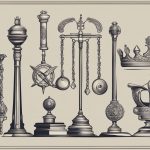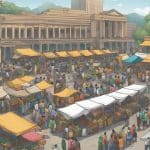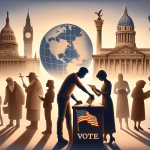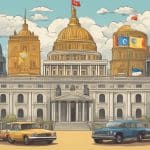Types Of Government Systems
Types of government systems are an integral part of the political system of a state. A government system is a set of institutions, political entities, and social organizations that work together to manage a state’s affairs. It is responsible for ensuring the well-being of its citizens by providing essential services, maintaining law and order, and protecting the state’s sovereignty.
Fundamental government concepts such as democracy, dictatorship, monarchy, and republic are essential to understanding the different types of government systems. Democracy is a government system that is based on the principles of popular sovereignty, political equality, and majority rule. In contrast, a dictatorship is a government system in which an individual or a group of individuals hold absolute power, and there is no opposition. A monarchy is a government system in which a monarch, such as a king or queen, holds supreme power, while a republic is a government system in which the power is held by elected officials.
Common government systems include presidential, parliamentary, and federal systems. Presidential systems are characterized by a separation of powers between the executive and legislative branches of government. Parliamentary systems, on the other hand, are characterized by a fusion of powers between the executive and legislative branches of government. Federal systems are characterized by a division of powers between the central government and the state or provincial governments.
Key Takeaways
- Understanding the fundamental government concepts is essential to understanding the different types of government systems.
- The most common government systems include presidential, parliamentary, and federal systems.
- A government system is responsible for ensuring the well-being of its citizens by providing essential services, maintaining law and order, and protecting the state’s sovereignty.
Fundamental Government Concepts

Sovereignty and State Power
Sovereignty refers to the supreme power and authority of the state over its territory and people. It is the ability of a state to govern itself without external interference. This includes the power to make laws, enforce them, and defend the state against external threats. The concept of sovereignty is closely linked to the idea of state power, which is the ability of the state to exercise control over its citizens and institutions.
Constitutional Frameworks
A constitution is a set of fundamental principles or rules that govern a state. It outlines the powers and limitations of the government and the rights and freedoms of the citizens. A constitution can be written or unwritten, and it can be flexible or rigid. A flexible constitution can be amended easily, while a rigid constitution requires a more difficult process to change.
Roles of Citizens and Authority
Citizens play an important role in a democratic government. They have the power to elect their leaders and hold them accountable for their actions. Citizens also have the right to participate in the decision-making process through various means such as voting, protesting, and petitioning. Authority refers to the power and control that the government has over its citizens. This includes the power to enforce laws, collect taxes, and maintain order.
In summary, understanding the fundamental concepts of sovereignty, constitutional frameworks, and the roles of citizens and authority is crucial to understanding the different types of government systems. By having a clear understanding of these concepts, individuals can better evaluate the effectiveness and legitimacy of their government.
Common Government Systems
Governments are organized systems that provide structure for societies. There are several types of government systems that exist in the world today. In this section, we will explore some of the most common government systems.
Democratic Governments
Democratic governments are characterized by free and fair elections, where citizens have the right to vote and participate in the decision-making process. In a democracy, the power is vested in the people, who elect representatives to govern on their behalf. Examples of democratic governments include the United States, Canada, and many European countries.
Authoritarian Regimes
Authoritarian regimes are characterized by a concentration of power in the hands of one person or a small group of people. These governments often do not allow for free and fair elections, and citizens have limited rights and freedoms. Examples of authoritarian regimes include North Korea, China, and Saudi Arabia.
Monarchies and Aristocracies
Monarchies and aristocracies are characterized by a ruling class that is determined by birthright. In a monarchy, the ruling power is vested in a king or queen, while in an aristocracy, the ruling power is vested in a group of people who are considered to be of noble birth. Examples of monarchies include the United Kingdom, Spain, and Japan, while examples of aristocracies include ancient Greece and Rome.
Overall, there are many different types of government systems, each with its own strengths and weaknesses. The type of government that is most appropriate for a given society depends on a variety of factors, including culture, history, and political ideology.
Government Systems by Integration
In a government system, integration refers to the process of connecting various internal and external systems and applications used within government systems. The integration of these systems is crucial for ensuring efficiency in securing data, communication, and moving documentation through necessary workflows.
Unitary and Federal Structures
In a unitary structure, the government has a centralized system of power, where the national government has the authority over all local governments. In this structure, the national government provides the necessary resources and support for the local governments to function effectively. In contrast, in a federal structure, the power is divided between the national and local governments, with each level of government having its own set of responsibilities and powers.
The integration of systems in a unitary structure is relatively simpler, as there is only one level of government to consider. However, in a federal structure, the integration of systems can be challenging, as the systems of the national and local governments need to be connected to ensure smooth functioning.
Confederations and Commonwealths
A confederation is a form of government where the power is held by the member states, with the central government having limited power. In this structure, the central government acts as a coordinator between the member states, and the member states retain their sovereignty. The integration of systems in a confederation can be challenging, as the member states have their own systems that need to be connected.
A commonwealth is a form of government where the member states have a shared history and culture, and the central government provides support and resources to the member states. In this structure, the member states retain their sovereignty, but the central government has more power than in a confederation. The integration of systems in a commonwealth is relatively simpler, as the member states have similar systems that need to be connected.
In conclusion, the integration of systems is crucial for ensuring the smooth functioning of government systems. The complexity of the integration process depends on the structure of the government, with unitary structures being relatively simpler than federal, confederate, and commonwealth structures.
Economic and Ideological Systems
Economic systems are the backbone of any government system. They define how a society produces, distributes, and consumes goods and services. Ideological systems, on the other hand, refer to the set of beliefs and values that guide the government’s policies and actions. In this section, we will discuss the four main economic systems and their relationship with ideological systems.
Capitalism and Socialism
Capitalism is an economic system based on private ownership of the means of production and the creation of goods and services for profit. It is characterized by free markets, competition, and the pursuit of individual self-interest. In contrast, socialism is an economic system that advocates for public ownership of the means of production and the creation of goods and services for the benefit of society as a whole. It is characterized by central planning, cooperative ownership, and the distribution of wealth.
Capitalism and socialism represent two opposite ends of the economic spectrum. Capitalism emphasizes the importance of individual freedom and the market’s ability to allocate resources efficiently. Socialism, on the other hand, emphasizes the importance of collective ownership and the government’s ability to ensure social welfare.
Communism and Maoism
Communism is an economic and political system that advocates for the abolition of private ownership of the means of production and the establishment of a classless society. It is characterized by central planning, public ownership, and the distribution of goods and services based on need. Karl Marx, the father of communism, believed that capitalism was inherently exploitative and that communism was the only way to achieve true social equality.
Maoism, on the other hand, is a variant of communism that emphasizes the importance of peasant revolution and guerrilla warfare. It was developed by Mao Zedong, the founder of the People’s Republic of China. Maoism emphasizes the importance of self-reliance, mass mobilization, and the rejection of traditional values and institutions.
In conclusion, economic and ideological systems are closely intertwined, and they play a crucial role in shaping a government’s policies and actions. Understanding the differences between capitalism, socialism, communism, and Maoism is essential to understanding the world’s political landscape.
Global Examples of Government Systems
When it comes to government systems, there is a great deal of variety across the globe. The following subsections will provide examples of different government systems from around the world.
Representative Democracies
Representative democracies are perhaps the most common form of government in the world today. In these systems, citizens elect representatives to make decisions on their behalf. The United States, Canada, and France are all examples of representative democracies.
In the United States, for example, citizens elect representatives to Congress, who then make decisions on behalf of their constituents. This system is designed to ensure that the voices of all citizens are heard, even if they cannot participate directly in government decision-making.
One-Party States
One-party states are those in which a single political party holds all the power. China and North Korea are both examples of one-party states. In these systems, the ruling party is typically authoritarian, and dissent is not tolerated.
In China, for example, the Communist Party holds all the power, and political opposition is not allowed. This system has allowed China to maintain a high degree of political stability, but it has also been criticized for its lack of democratic accountability.
Theocratic Governments
Theocratic governments are those in which religious leaders hold political power. Iran is perhaps the best-known example of a theocratic government, with its Islamic Republic system. In these systems, religious law is often incorporated into the legal system, and religious leaders make decisions on behalf of the government.
Brunei is another example of a theocratic government, with its system of absolute monarchy. In Brunei, the Sultan is both the head of state and the head of government, and he is also the supreme religious leader of the country.
Other Examples
There are many other examples of government systems around the world, including constitutional monarchies, socialist states, and more. The Czech Republic, for example, is a parliamentary republic, while Oman is an absolute monarchy. Cuba is a socialist state, while the Islamic Republic of Iran is a hybrid theocratic republic.
Overall, the variety of government systems around the world is a testament to the diversity of human societies and the different ways in which people have organized themselves politically.




